Triumph:
List of manuals on repairing English motorcycles Triumph Tiger
See this section in russian language
This manual is intended for the maintenance and repair of motorcycles «Triumph Tiger 800» (800XC), including models with ABS, manufactured from 2010 to 2019.
Description and history of English motorcycles Triumph Tiger
| Content: | Tiger 800 Tiger 900 (T400) Tiger 955i Tiger 1050 Tiger Explorer Tiger 900 Tiger Sport 660 |
Tiger 800 (2010-2020)
The Triumph Tiger 800 is a motorcycle model from the English motorcycle brand Triumph Motorcycles. The travel enduro has been manufactured in two versions in England and Thailand since 2010.
The idea for the "little Tiger" under the 1050 comes from 2007. The characteristic duckbill, the double headlights, the silhouette and the color scheme are similar to the BMW F 800 GS. It is also not denied that the "little" GS, among others, was the inspiration for the development. Many of the style-defining elements of the GS were not introduced by BMW, for example the duckbill comes from the Suzuki DR Big 750 S. Triumph also has a long history in the off-road sector and, after the entire company temporarily closed down, has had Tiger models in its portfolio again since the early 1990s.
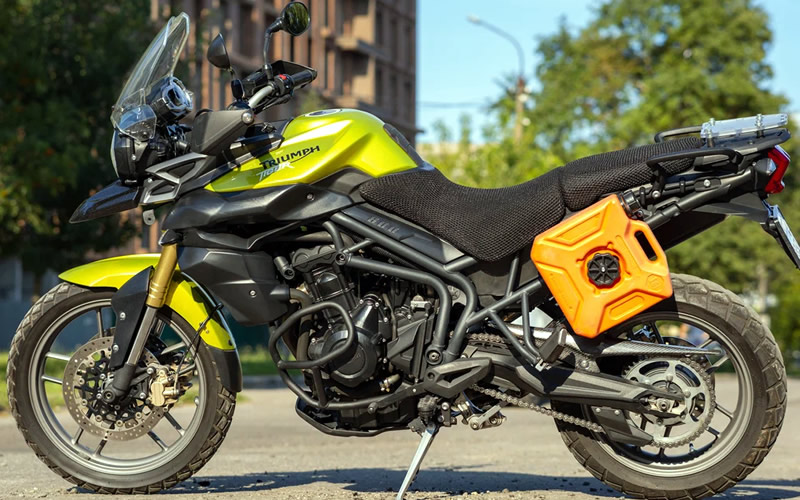
Tiger 800, 2011 year, left view
At the beginning, two variants were offered.
- The basic model without any additional name is intended as a motorcycle for everyday use and touring; it is lower with shorter suspension travel and is primarily intended for use on paved roads.
- The variant with the additional designation "XC" (cross country) differs from this in that it has spoked wheels, the front of which is larger than on the road variant, studded tires and longer suspension travel, which should also make the motorcycle suitable for off-road use.
Both models were optionally available with a switchable anti-lock braking system (ABS) and extensive accessories.

Tiger 800, 2015 year, right view
The Tiger 800 was fundamentally revised for the 2015 model year. The frame, chassis and basic concept remained the same, but in addition to detailed changes in comfort (operation of the on-board computer, adjustability of the windshield, etc.), the engine control in particular was further developed into a modern concept. A ride-by-wire throttle control enables various engine mappings, cruise control, traction control and other features.
From 2018, the street variant was given the additional name XR and was offered in four sub-variants:
- XR: basic model
- XRx: additional TFT color screen, backlit controls, five-way adjustable windshield and four driving modes
- XRx low: like XRx, but with a lower seat height (adjustable)
- XRt: compared to the XRx, additional features such as five driving modes, seat and heated grips.
The XC variant received the sub-variants XCx and the slightly higher-quality XCa. All variants share the same platform.
From the 2020 model year, the Tiger 800 was replaced by the Tiger 900. In contrast to the model updates in 2015 and 2018, this is a completely newly designed motorcycle.

Tiger 800, 2012 year, dashboard
The liquid-cooled three-cylinder engine generates a nominal output of 70 kW (95 hp) from a displacement of 799 cc and a maximum torque of 79 Nm at a speed of 7850 min-1. The three cylinders have a bore of 74 mm diameter, the pistons have a stroke of 61.9 mm and a compression ratio of 11.1:1. Two chain-driven overhead camshafts rotate in the cylinder head of the transversely installed in-line engine, which control two intake and two exhaust valves via rocker arms.
The motorcycle accelerates from 0 to 100 km/h in 4.3 seconds and reaches a top speed of 210 km/h. In a long-distance test over 50000 km, the magazine Motorrad measured an average fuel consumption of 5.8 liters per 100 kilometers.
Tiger 900 "T400" (1993-1998)
The Triumph Tiger 855i (originally called Tiger 900, but also Tiger T400 or simply Tiger) is a motorcycle produced by the English motorcycle manufacturer Triumph from 1993 to 1999.
Introduced in 1993, the Tiger is a large-displacement enduro. It has a forward-tilted, front-facing, three-cylinder in-line engine of 855 cc (derived from the Triumph Daytona 900), with a 12-valve twin camshaft distribution and assisted by a 6-speed gearbox with chain final drive. The four valves per cylinder are operated by two overhead camshafts driven by a chain. The power is approximately 78 hp.

Tiger 900 "T400", 1993 year, right view
The bike is built on a tubular steel frame, aided by a suspension system consisting of a single-sided aluminum swingarm at the rear and a telescopic fork at the front.
In 1999 it was heavily modified (model known as the T709), using a fuel injected version of the 885 cc engine. In 2001 it was replaced by the Triumph Tiger 955i.
Tiger 955i (2001-2006)
The Triumph Tiger 955i is a motorcycle produced by the English motorcycle manufacturer Triumph Motorcycles from 2001 to 2006. It was subsequently replaced by the Triumph Tiger 1050 introduced in 2007.
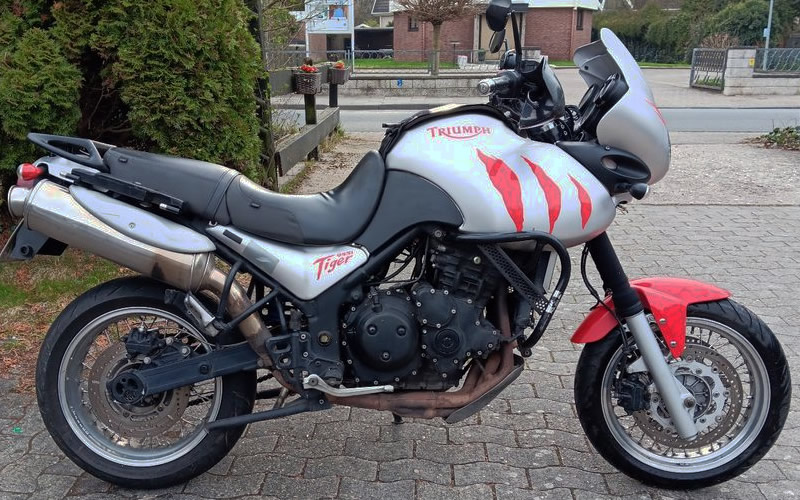
Tiger 955i, 2002 year, right view
The engine is a 955 cc three-cylinder, with 12-valve dual overhead camshaft distribution, 4 per cylinder with direct injection and assisted by a 6-speed gearbox.
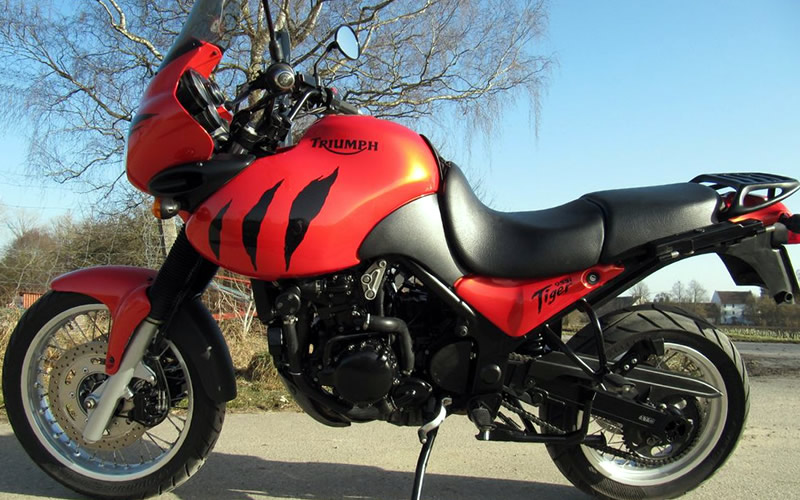
Tiger 955i, 2004 year, left view
Braking is guaranteed by two 4-piston radial calipers with 310 mm diameter discs at the front and a 285 disc, but with 2-piston calipers at the rear.

Tiger 955i, 2003 year, dashboard
In 2005 it underwent a technical and aesthetic restyling. The chassis has been tweaked with shortened suspension travel, a new rear swingarm, new alloy wheels with tubeless tyres and the frame is painted silver.
Tiger 1050 (2007-2021)
The Triumph Tiger 1050 is a motorcycle produced by the English motorcycle manufacturer Triumph Motorcycles presented in 2006 and produced until 2021.
The engine is the same 1050 cc three-cylinder as the naked Speed Triple 1050 although "softened" to adapt it to multipurpose use.
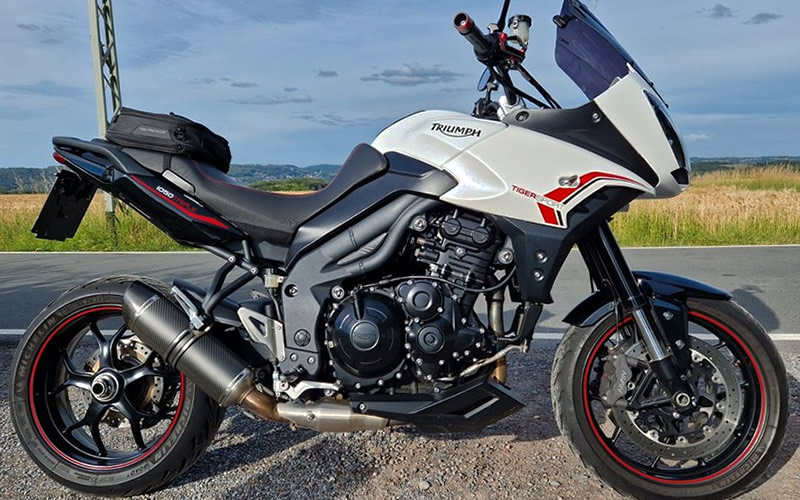
Tiger 1050, 2013 year, right view
The new Tiger, unlike the previous Tiger 955, has no off-road vocation. Rather, it belongs to the new type of multipurpose motorcycle, suitable for both urban roads and extra-urban roads, mountains and even motorways, such as, for example, the Kawasaki Versys. The design of the Tiger 1050 is by Rodolfo Frascoli of Marabese Design.
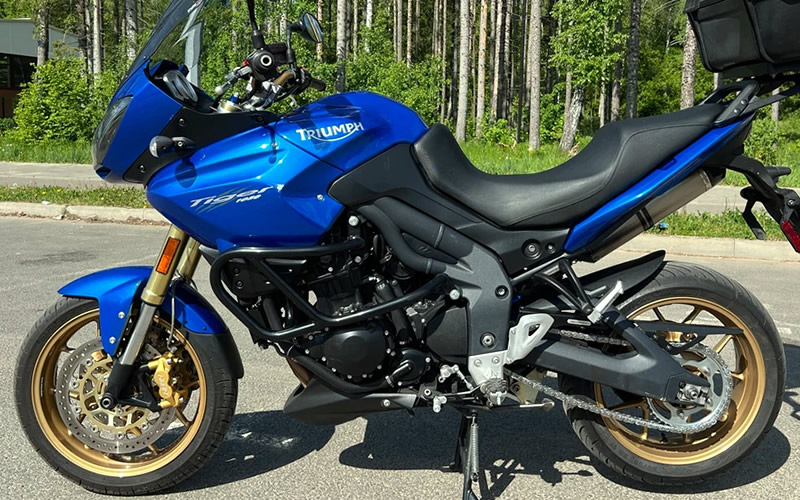
Tiger 1050, 2009 year, left view
With the transition to the new 1050 cc three-cylinder engine, the new Tiger also changes its attitudes and, despite the chassis maintaining its enduro structure, it gains all the attributes of a sport tourer. The front wheel in fact goes from 19" to 17" in diameter, always with the upside-down fork, now adjustable, gaining a manageable and light front end suitable for getting out of traffic jams.

Tiger 1050, 2008 year, dashboard
At first glance, the imposing bulk of the bike gives the idea of heaviness, but appearances are deceiving as the declared weight is only 200 kg dry, a good 17 less than the previous version; this should guarantee a certain ease of use even if it turns out to be more suitable for tall people (those who are less than 1.75 m tall, even though the saddle is lowered, struggle to touch the ground).
Braking is ensured by two radial calipers with 4 pistons with 320 mm diameter discs at the front and a 255 disc, but with 2 piston calipers at the rear and with the possibility of also adopting the ABS system.
Although it is the same three-cylinder that equips the sportier Speed Triple 1050, the engine has been revised to deliver its "horsepower" more smoothly even if with its 117 hp the "Tiger" is, in 2007 when it was released, the most powerful street motard on the market. It is an engine capable of pushing smoothly in the city, but capable of impressing with its vigor on the road since it is possible to open the throttle at just over 1000 rpm in sixth gear and extend up to 10000. In short, an "easy" engine, but not too much, not suitable for those who have no experience with engines above 100 hp.
Tiger Explorer (2012-current)
The Triumph Tiger Explorer is a motorcycle produced by the British motorcycle manufacturer Triumph Motorcycles since 2012.
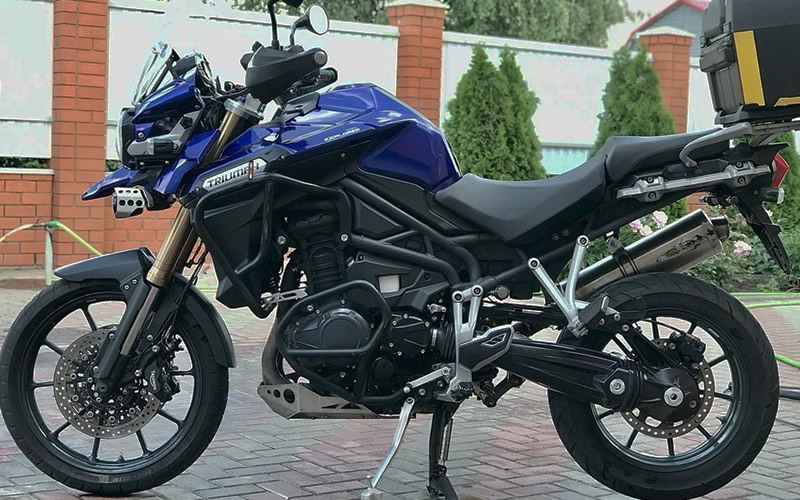
Tiger Explorer, 2012 year, left view
Previewed at the EICMA in November 2011 and produced in Hinckley, England, it is available in two models; the Tiger 1200 GT and the Tiger 1200 Rally. Both models have similar specifications, but the Rally features an off-road oriented setup with spoked wheels instead of the cast aluminum ones found on the GT.
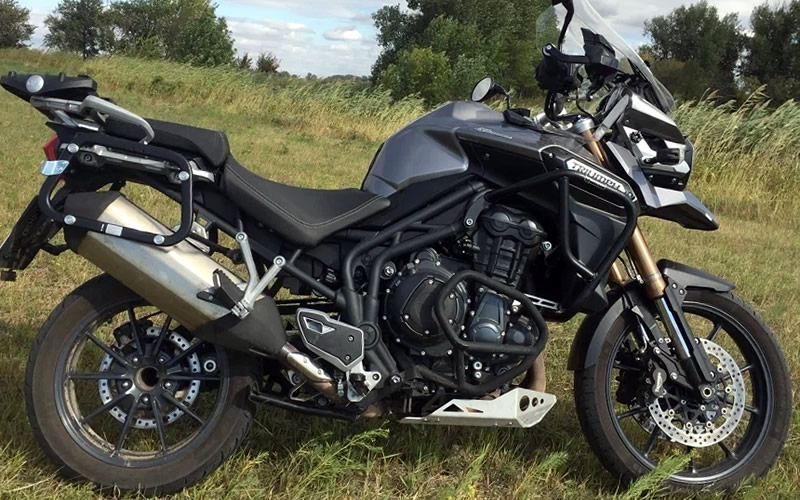
Tiger Explorer, 2014 year, right view
The engine is a 1215 cc three-cylinder, with DOHC distribution and 12 valves, 4 per cylinder with indirect fuel injection and assisted by a 6-speed gearbox with shaft final drive. The four valves per cylinder are operated by two overhead camshafts driven by a chain. The cylinders have a bore of 85.6 mm, a stroke of 71.4 mm and a compression ratio of 11:1. The exhaust gas treatment is carried out by a catalytic converter that at its debut satisfied the Euro 3 pollutant class, but since 2016 it has been updated to Euro 4. The three exhaust manifolds flow into a stainless steel rear silencer on the right side.
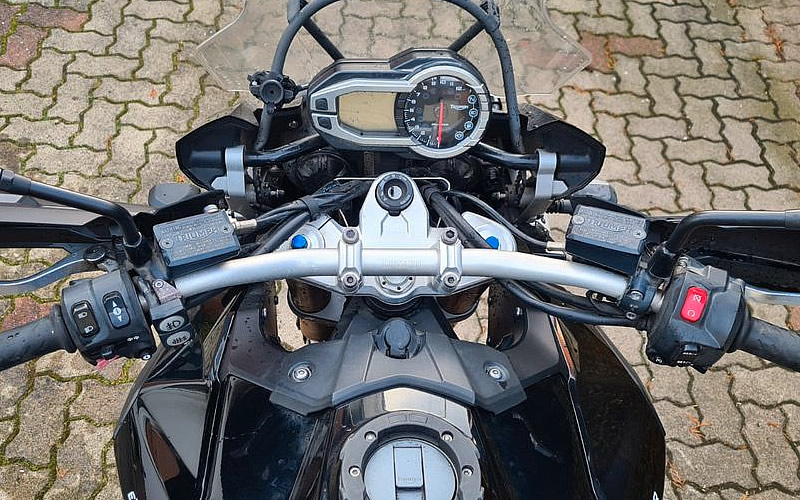
Tiger Explorer, 2013 year, dashboard
The bike is built on a tubular steel frame, supported by a suspension system consisting of a single-sided aluminum swingarm at the rear and a 46 mm diameter upside-down telescopic fork at the front. Braking is guaranteed by two 4-piston radial calipers with 305 mm diameter discs at the front and a 282 disc, but with 2-piston calipers at the rear.

Tiger 1200, 2018 year, left view
In 2017 it underwent a major restyling both technically and aesthetically, changing its name to Tiger 1200.
Tiger 900 (2020-current)
The Triumph Tiger 900 is a motorcycle produced by the English motorcycle manufacturer Triumph Motorcycles since 2020.
Introduced in early December 2019 and in production at the Bangkok plant in Thailand starting from 2020, it is a large-displacement enduro. The bike takes up the name already used on the Triumph Tiger 900 T400 produced in the 90s, but this model is completely different and replaces the Triumph Tiger 800.

Tiger 900, 2021 year, left view
It mounts a new 888 cc forward-tilted three-cylinder in-line engine, which develops a power of 95 hp at 8750 rpm and a torque of 87 Nm at 7250 rpm. The three-cylinder engine has a 12-valve distribution, with multipoint indirect injection and is supported by a 6-speed gearbox with chain final drive. The four valves per cylinder are operated by two overhead camshafts driven by a chain.

Tiger 900, 2024 year, right view
The exhaust gas treatment is carried out by a catalytic converter that meets the Euro 5 pollutant class. The bike is built on a tubular steel frame, supported by a suspension system consisting of a single-sided aluminum swingarm at the rear and an upside-down telescopic fork at the front.
Compared to the previous 800, the Tiger 900, in addition to a new engine (with a special crankshaft called "T-Plane") and larger, adopts a larger fuel tank and Full LED lights. In addition, significant updates have been made to the suspension and new Brembo disc brakes have been fitted.

Tiger 900, 2022 year, dashboard
There are six variants: the base model, GT, GT Low, GT Pro, Rally and Rally Pro. The GT, GT Pro, Rally and Rally Pro versions feature a 7-inch TFT display, ABS anti-lock braking system and traction control. The GT models are more road-oriented; like the base model, they are equipped with steel wheels. The GT Low (short for "Low Ride Height") has a different suspension tuning and a lower seat height. The Rally models are more off-road-oriented and feature spoked wheels with tubeless tires and a 40-millimeter higher seat than the GT.
Tiger Sport 660 (2022-current)
The Triumph Tiger Sport 660 is a medium-displacement motorcycle (660 cc) produced by the English motorcycle manufacturer Triumph since 2022.

Tiger Sport 660, 2023 year, left view
The Tiger Sport is a medium-displacement sport-touring crossover, equipped with a perimeter frame in steel tube trellis.
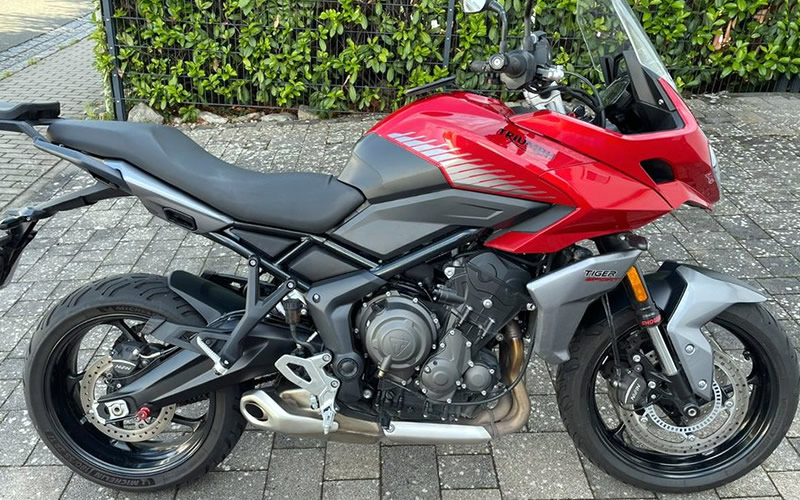
Tiger Sport 660, 2022 year, right view
The engine, which was developed using the 660 cc Triumph Street Triple S as a base, is a 660 cc three-cylinder in-line four-stroke engine with a liquid cooling system that produces a maximum power of 81 hp and delivers a torque of 64 Nm. The distribution is with two overhead camshafts (DOHC) with 12 valves (4 per cylinder), being fed by an indirect multipoint electronic injection system. The engine is managed by a six-speed gearbox with frontal clutches.
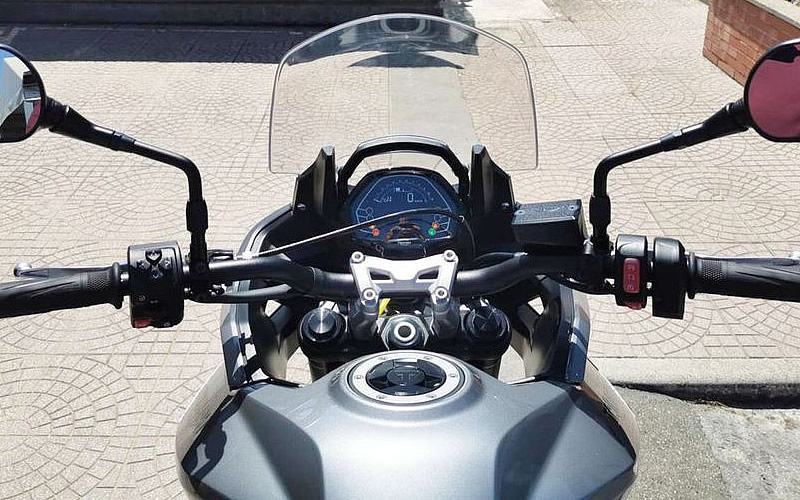
Tiger Sport 660, 2024 year, dashboard
The two floating disc brakes at the front have a diameter of 310 mm and are actuated by two-piston calipers. At the rear there is a disc brake with a diameter of 255 mm and a single-piston caliper. The tires at the front measured 120/70 ZR 17 while at the rear 180/55 ZR 17.
- Information for owner
- Introduction to manual
- Technical tricks
- Engine and systems
- Engine repair
- Lubrication system
- Cooling system
- Fuel and control system
- Transmission
- Running gear and frame
- Frame and hinged elements
- Front suspension and handlebar
- Rear suspension
- Brake system
- Wheels and tires
- Electric equipment
- Equipment and devices
- Starting and charging system
- Electrical circuits
